» Home
» About
» Membership
» Journal
» Sparoza Garden
» Branches
» MGS Forum
» Seed Exchange
» Donations
» MGS Excursions
» Information
» Members' Gardens
» Book Reviews
» News & Views
» Contact
» Search
BRANCH HEAD

Christina Lambert
Information and
resources for Greece
Ελληνικό ιστότοπος του MGS
|
The Greek Branch of the MGS
Past Events 2017 2016 2015 2013 2012 Older
November 2014
Visit to a garden in Varnava, Attica
Varnava lies between Kapandriti and the Gulf of Evia in a hilly area north of Athens and beyond its northern suburbs. When the owner bought her property in the late 1970s, she acquired a 4500 square metres field sloping toward a seasonal stream lined with plane trees and looking beyond to more sloping hillsides and small ravines covered with pines. Extensive stretches of arbutus and schinia or lentisk (Pistacia lentiscus) cover the side facing Evia around the main gate. It feels remote and wild even today despite the fact the village itself has grown considerably since then.

The view to the main gate
Photo by Robin McGrew
The owner’s first thought was to plant trees in the lower half of the plot, in order to give them a head start before building. She chose fruit trees of all kinds, from walnut trees near the stream to almond, olive, apricot, apple, pear, plum and fig trees on the slope. She also planted Cedrus atlantica ‘Glauca’ on the southern boundary line to cut off the field next door (from the prying eyes of potential neighbours). In the process of watering and caring for these trees, paths formed naturally and the plot became domesticated. Yet, several years later, when the bulldozer moved in to clear the site for building in the upper section, the owner found herself in what suddenly felt like ‘alien territory’.
After the house was built in the mid-1980s, the owner set about slowly reshaping the sloping land with more plants and paths, following her own instincts rather than a professional’s advice or design. The planting had a logic. It was important to mould the house into the terrain, but the owner preferred to shore up the soil with large boulders found on the plot rather than resorting to retaining walls. She pointed out that the real work of soil retention is done by the plants themselves: lots of rosemary, sage, and lavender, which all grew from cuttings or sprigs. ‘I very rarely buy plants, instead I grow them from seed or from cuttings. And of course I have many volunteers that I just leave where they sprout.’ As she says, the emphasis was on the practical: ‘Because I didn’t have much help in the garden, the plants had to be easy, to look after themselves. And it also seemed to me that hardier, wilder-looking plants would not only be happier here, they would also fit into the landscape.’
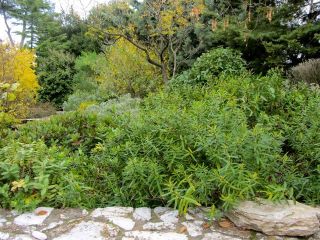
Dense greenery with yellowing autumn leaves and a typical stone wall
Photo by Diana Farr Louis
What our hostess has accomplished is a harmonious, informal garden on several levels that flow into each other, linked by unpaved paths. There is no strict hierarchy: a cabbage patch flourishes in front of a shed, a circle of cherry tomatoes provided summer colour next to the gate, while artichokes poke up their spiky leaves in places ‘where I had space to put them’. The levels parallel with and above the house and its spacious main bricked terrace contain more ornamental plants – magnificent irises in spring preceded by a row of agapanthus grown from seeds sown one by one by the owner’s mother, a red-leafed berberis ‘placed against the light so its colours will glow in the sun’, a gorgeous cotoneaster with its ruby ‘fruit’, some Nandina domestica, but also some very decorative Myrtus communis with dark berries, and behind them an arbutus with its red/yellow ‘furry’ fruit.

A red-leafed berberis placed against the light
Photo by Diana Farr Louis

Some very decorative Myrtus communis
Photo by Robin McGrew
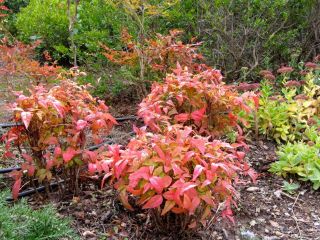
Nandina domestica grows near the berberis, forming a patch of red
Photo by Diana Farr Louis
She told us that she aims for soothing blues and lavenders in spring and soft reds and yellows in autumn, but relegates bright colours that she fears will clash with the muted greens of the shrubs to pots on the terrace. There attractive stone and terracotta pots spilled over with autumnal chrysanthemums, reddish ivies and some pink snapdragons confused by the warm weather. And beyond that, to the right of some yellowing pomegranate trees and hidden away behind some evergreens, was a rock-lined ‘pool’ filled with spinach seedlings and a compost heap. We had to watch where we walked for fear of treading on cyclamen that spread in impromptu ‘rivers’ and ‘ponds’ throughout the garden.

Autumnal chrysanthemums decorate the patio
Photo by Diana Farr Louis
What makes this garden even more special is the dialogue the almost tamed property maintains with the still wild, completely unspoilt mountainside around it. A white limestone outcropping, stands of tall dark pines, young bright green pine bushes (recovering from the fire in 2007), and the yellowing foliage of deciduous trees kept drawing our eyes beyond the planted areas. It felt like such a treat, such a luxury to have the comfort of a casually imposed order enhanced by the views of the ‘great outdoors’.

Wild and planted blend happily when you don't know where one starts and the other begins
Photo by Robin McGrew
Hats off to RB for having created another very special garden on a Greek hillside.
Diana Farr Louis
May 2014
Trip to South Pelion or ‘How the other half gardens’
Waterwise is not an expression one encounters in Pelion. Not one of the eleven gardens we visited during our sojourn on the peninsula bore any resemblance to the dry, sometimes austere, drought-resistant plots we nurture in Attica and the Peloponnese. Instead, they were lush, sporting an extravagant array of flowers and trees more often enjoyed in northern climes like southern England and the eastern United States. Streams coursed through them, most of them possessed fountains, natural springs or pools, and every single owner had installed elaborate watering systems as well. All were exceptional in different ways. Quirky works of art and found objects, standing proud or waiting to be discovered among the greenery, were featured in many of the gardens.
Our polyglot group of about 26 members from four foreign countries as well as us locals from various corners of Greece was splendidly catered for by MGS member Sue Wake and her partner Christian Lefaucheux at their newly-opened country hotel, Lagou Raxi (www.lagouraxi.com), near the village of Lafkos. We owe Sue a triple vote of thanks, since not only was she our gracious hostess but she had also planned the entire programme and acted as our guide throughout. Sue fell for this relatively remote area of Greece in 1988 and she and Christian have a vision to introduce other discerning travellers to the area. They are creating gardens for pleasure and to supply organic produce for the hotel restaurant. We especially admired her peony.
After lunch at a tsipouradiko in Volos harbour, we set off for Ano Lehonia to see one of the only three gardens that were not arranged on terraces on a steep slope. Owned by a Franco-Greek couple who had recently retired there, it definitely belonged to what we think of as the French tradition: orderly with clear divisions between types of plants, all in impeccable condition. For a garden that was only four years old it seemed remarkably mature, partly thanks to the presence of 80 venerable olive trees. The owners had not been able to resist the temptation of a lawn, but were in the process of segregating the centuries-old trees from the watering system that threatens to give them more than they need. Among the 250 species flourishing in beds in this paradise were multicoloured verbena, amazing irises, ceanothus, lobelia, fuchsias, papyrus, as well as more ‘Mediterranean’ shrubs like plumbago, rosemaries, echiums, and a thriving vegetable area with a strawberry patch some of us found too alluring to pass without a taste.
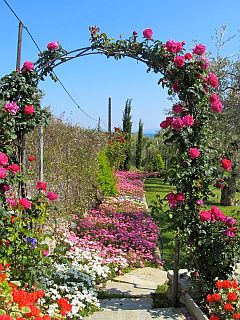
A rose gateway leading to beds of luxuriant verbena
welcomed us to the first garden at Ano Lehonia
Photo by Diana Farr Louis

One by one, the old olives are being 'segregated'
from the lawn's watering system
Photo by Diana Farr Louis
Day 2 began with most of us piling into a minibus embellished with a kitschy but charming portrait of a centaur for a breathtaking drive above the south-east coast to our first garden at the end of nowhere. Created by an Austrian summer resident who ‘bought the house 13 years ago for nothing because it was worth nothing’, this was our most vertical garden and certainly one of the most spectacular ones, in terms of both views and plants. We entered through a tunnel-like gate draped with creeping rosemary and filed down paths flanked by walls of ‘golden’ stone and shrubs sculpted into smooth curves. The garden itself was a study in bringing order out of the chaos of the surrounding rocks and precipices, stunningly complemented by nature’s spontaneous growth in their crevices and seemingly inhospitable surfaces, and by some striking sculptures. Our host astonished us by saying that he uses 7 cubic metres of water daily in summer, that his lemon trees prefer ‘dry heads and wet feet’, and that even his cactus beds are attached to a hose.
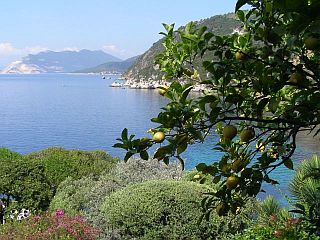
A lemon tree and neatly trimmed shrubs and trees frame a spectacular view
Photo by Linda Reynolds
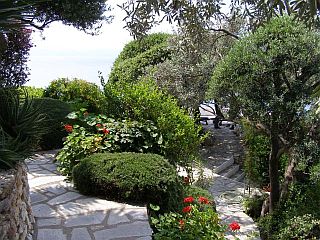
Winding stone paths lead to a shady spot overlooking the sea
Photo by Linda Reynolds
The steep hill was too much for our minibus’s small engine, so we got out to lighten its load, and we were rewarded by closer looks at the pink orchids (Anacamptis laxiflora, syn. Orchis laxiflora), gladioli, hypericum and dark blue salvias on the roadside, where fragrant broom and both pink and white cistuses also abounded.
In the next, six-year-old, garden, owned by British residents, the distinction between planned cultivation and nature’s ebullience was blurred. Magenta valerian erupted from rocky areas, while white roses shared space with pale blue Globularia and exotic bird of paradise (Strelitzia reginae) snuggled next to hardy ice plant (Delosperma cooperi). A delightful informality prevailed thanks in part to our hostess’s collection of stray cats and dogs awaiting adoption; she and two friends started PAWS (Pelion Animal Welfare Society) which last year found homes abroad for 50 abandoned dogs. Amidst this menagerie stood a life-sized heifer left over from the famous Cow Parade that toured Europe a few years back.

The distinction between cultivated and wild was deliciously blurred
Photo by Diana Farr Louis
By this point, tummies were signalling that it was time for lunch and we pulled into the tiny bay of Katigiorgi, where Stamoulis served us a 20-course feast by a sparkling sea, fortifying us for our next garden. This was a work in progress, owned by a British couple who had been coming for seven years on holidays and had arrived ‘with a one-way ticket’ only four weeks before we descended on them. Their gardeners, Spyros – also a master tiler, who had designed and laid attractive paths – and his son, Alekos, showed us around the steep plot. Old olives, red geraniums, ice plant, cistus, rose-scented geranium (Pelargonium graveolens), amaryllis and irises were already in place, but a large swathe of hillside had been denuded of all vegetation as far as the vegetable patch at its bottom. Spyros told us he’d wanted to lay bare the interesting rock formations and was open to suggestions of what to plant. We offered a few ideas and knew the couple would be happy filling in the blanks and gazing at the serene, grey-green blanket of pines and olives on the hill opposite.
From there we drove to another beach, Theotokou, where we spied remains of an early Christian church and a bit of mosaic flooring, which led one of the archaeologists in our group to speculate on the presence of older antiquities on the outcropping above it. The next day he clambered to the acropolis and found ruins and shards dating back to the Geometric period.
Day 3 got off to a hearty start as the walkers among us hiked down the kalderimi – traditional cobbled path – from Lafkos to Milina. Along the way we were rewarded by sightings of ophrys and serapias. From there we drove to a waterfront garden being created by an indefatigable 70-something woman named Kyria Katya. After her architect husband bought the land in 1968, they installed a protective, north-facing boundary of stone walls, terraces and a jetty. These were bordered with and hardy evergreen shrubs like lentisc (Pistacia lentiscus), oleanders, limoniastrum and rosemary as well as evergreen trees which are now fully mature. The couple moved from Athens to Pelion three years ago and she’s been making up for lost time by gardening long hours: 6 am to 9 pm! Her beds and groupings featured enchantingly eclectic combinations of plants. Yuccas or figs intertwined with olives, cacti cosied up to daisies, and everywhere we looked we saw evidence of Katya’s green thumb – boxes of baby succulents ready to enter the ground. We also pored over her nursery, for she grows all her plants from seeds and cuttings. We marvelled at her energy and passion.

Kyria Katya's mix of succulents and evergreens, colours and textures
Photo by Diana Farr Louis
Thoroughly inspired but daunted by her example, we moved on to Trikeri, the large village at the southern tip of Pelion, and lunch at To Agnadi, a place with a stellar view as its name implies. Then we bobbed down to the coast at Agia Kyriaki for a glimpse of the Folk and Maritime museums before returning to Lafkos where we visited the Radio Museum, the only one of its kind in Greece.
On Day 4 we kept close to home initially, visiting an ‘urban’ garden in Lafkos village and the Sixth Plant and Crafts Fair in the square. The garden, owned by a Greek geologist and his South African wife, was a perfect example of how to manage a small space, with an artful mixture of mini beds, large pots and wall niches under a towering lime/linden tree (Tilia sp.). A huge angelica welcomed us with its perfume; irises, salvias, solanums and lavenders displayed various shades of mauve and blue; while red roses climbing on the wall of an abandoned house next door added a big splash of colour. Our hostess had done a splendid job of camouflaging other, less attractive features on adjacent properties.
As for the Fair, it was lively and well attended, presided over by the largest cypress tree any of us had ever seen.
Then on to a garden facing the Pagasitic Gulf owned by German residents, a botanist and a chemical engineer/soil scientist. Mr B gave us a talk on his philosophy regarding soils and fertilisers, urging us to measure the pH of the soil in our gardens and add nutrients accordingly. He told us that he shreds everything – including olive leaves and branches – to make mulch and then spreads a layer of manure under it to make up for the loss of nitrogen caused by the decomposing mulch. As a result, his beds were springy enough to bounce on. He also waters a little every day, believing that deep watering will increase salinity and drain essential minerals. He must be doing something right; every plant looked blissfully happy. Among his prizes were a couple of magnificent Bauhinia variegata var. candida (syn. B. alba) that took us a few minutes to identify, Tecoma stans, a pepper tree, jacaranda grown from seed, some small lily ponds, as well as 30 old olive trees, which produced 3 tonnes of fruit last harvest. But his triplet toddler grandchildren drew as many cries of pleasure and surprise as his horticultural wonders.
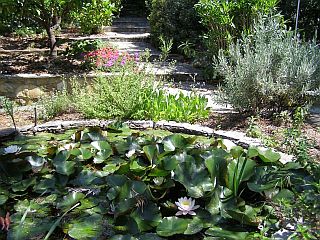
A lily pond in a shady corner contrasts beautifully with the stone paving
Photo by Linda Reynolds
Lunchtime found us at the restored early eighteenth-century Paou monastery, enjoying a gourmet picnic in its peaceful cloisters, which provided the pause that refreshes before we headed on to two more gardens. The first had been bought 12 years ago by a British non-resident from a German couple, whose presence was still felt in the terracing and imaginatively tiled fountains. J told us that he had given the garden a more ‘Mediterranean’ feel that was more ‘him’, planting plumbagos, wisteria, echiums, nasturtiums under a vine-covered pergola and a melia tree with gorgeous white flowers. He had transplanted two palms introduced by his predecessors, which had thanked him by shooting skywards, and arranged several delightful corners to sit and admire the views of the sea and of the enormous ‘Ali Baba’ jars placed to complement the rocks and plants.
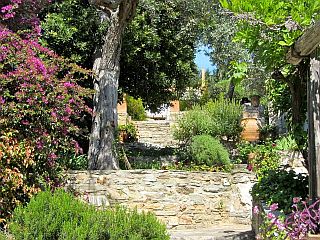
Terraces, Ali Baba jars and a Mediterranean 'feel'
Photo by Diana Farr Louis
From there we paid a visit to the new Milea winery owned by Lazaros and Suzanna Karipidis, whose Merlot and Chardonnay we’d been enjoying at dinners at the hotel. Their vineyard had the added bonus of being next to a field of pink orchids (more Orchis laxiflora). Our final garden belonged to a German couple and displayed a pleasing combination of the wife’s art and mosaics, amber stone walls and sense of colour. As if she were ‘painting’ with flowers, she had juxtaposed different shades of orange blooms that blended beautifully with the walls. Like the other gardeners, she also had a soft spot for succulents, and a fondness for pots, some of which held lovely crimson-speckled white orchids. All of the South Pelion properties had been carved out of olive groves, each tree of which was a natural wonder. The last three gardens, facing west, had been designed to use foliage to combat the extreme heat of early evening in the summer months.
On our final day we left the land of the olive and drove north along the ridge of Pelion through dense forests of chestnuts, planes and other enormous deciduous trees that turned to dark beech as we got higher. Somewhere close to Tsangarada, we stopped at Doris Schlepper’s Serpentin garden (http://www.serpentin-garden.com/welcome.html), a fairy tale place of snake motifs, old metal gates, small pools, ‘English-type’ plants, sculptures and beach finds, barnyard fowls and an atmosphere of pure enchantment. Following the overgrown paths to the many levels, we felt like children discovering a new world. There was something unexpected at every turn – fat pink foxgloves, a mannequin’s lower half filled with drooping ivy, exquisite irises, extravagant clematis, a tiled fountain, a duck pond, a raspberry patch, more than 50 types of rose, even a ‘bee and beetle hotel’ made of cleverly stacked perforated logs. We could not get enough of it or our hostess, who is contemplating retiring to Frankfurt. All we can say is Bravo to Ms Schlepper for having created such a horticultural/artistic masterpiece, and we urge any of you who can to contact her via the website and make an appointment to visit before she departs.

Foxgloves, irises, columbine - are we in England or in Greece?
Photo by Linda Reynolds

Doris’s wonderful clematis
Photo by Diana Farr Louis
The Serpentin was a hard act to follow but we had one more stop – on the other side of the mountain – at Drakeia about 700 metres above sea level overlooking the Pagasitic Gulf. There a British, Greek-trained plastic surgeon has created a charming, casual garden 50 steps below the road into town on a steep slope with a river gushing at the bottom. Besides four donkeys, we spotted more colourful irises and clematis amidst abundant greenery, and congratulated her on her agility in this near vertical environment. With tiny glasses of tsipouro we toasted the success of our marvellous five days but we all had miles to drive before we slept and so we reluctantly remained sober, though enormously grateful to Sue Wake and all the garden owners who had so generously allowed us to invade their very special precincts.
As one member wrote, and most of us felt, ‘I came away with two slightly contradictory thoughts. First, so far as gardening successfully is concerned, there is no right way; there are several routes towards a wonderful garden. Second – and less optimistically – I have a great way to go before I could invite the MGS to visit!’
Diana Farr Louis
March 2014
Visit to a member’s garden near Keratea, Attica
This garden in the dry and stony hills of south-east Attica is such a showpiece of waterwise principles that we featured it in our AGM programme in November. Wanting to give local members a chance to see how these principles have been implemented, we asked the owner if she would open her gates again. Not only did she accept, she even repeated her generous spread of delicious home-made cakes, biscuits and juices that had some gardeners begging for recipes.
Originally, the property consisted of attractive old olive trees, to which a newer grove was added about twenty years ago, along with fruit trees, ornamental trees and shrubs near the house for shade, and terraces made especially for vegetable patches. After working as a regular volunteer at Sparoza, however, the owner decided she’d like to apply the concepts of waterwise gardening at home. Four years ago she enlisted the help of Jennifer Gay and Piers Goldson and a new phase of garden development began.
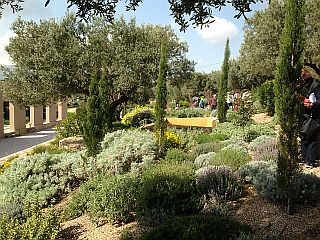
A more established part of the garden near the entrance
Photo by Robin McGrew
They envisaged the introduction of a new layer of drought-resistant shrubs and perennials that would create a new dimension and structure within the garden. To ensure success, they have sourced all the plants from Olivier Filippi’s nursery near Montpellier in the south of France. Filippi’s seedlings are grown to withstand a life without summer water. Even before ordering them, the team prepared the soil to improve drainage, incorporating river sand where necessary. The Keratea plants receive approximately 15-30 litres of water per month during their first summer according to species, and thereafter a regimen of trial and error is applied towards reducing the need for watering, the ultimate aim being no irrigation except for infrequent but deep watering for selected plants only.
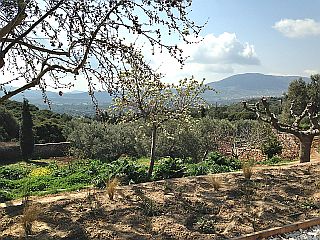
The view of the Mesogeia plain and a newly dug bed
Photo by Robin McGrew
Diana Farr Louis from Jennifer Gay’s notes
One member’s reaction to the Keratea garden
Along with around 40 other horticultural enthusiasts, I had the opportunity to visit the garden of a fellow MGS member located near Keratea, about 40 kilometres south-east of the centre of Athens. The first thing that struck me when I entered the property was how easily the garden harmonized with the surrounding landscape, visible from three sides of the grounds. This is a garden that fits in well with the adjacent olive groves and vineyards. As I began to look closely at the garden, however, I could appreciate how carefully arranged the trees, shrubs and perennials were to provide variety in colour, texture and shape.

A typical example of the mingling of textures, colours and shapes in the Keratea garden
Photo by Robin McGrew
I love the columnar forms of cypress trees. Here they are deployed to punctuate different areas and help move the eye (and entice the body to follow) through the garden. I also love spiky shapes. Here I see a yucca-like plant with delicate thin spikes and a perfectly round shape that appears in several places to great effect. What is this specimen? Throughout the garden, various plants were in flower and I can imagine this is typical through much of the year. The scent of a yellow flowering shrub was delicious. I describe myself as a horticultural enthusiast; unfortunately, this does not mean I know the names of many plants found in this part of the world.

Filippi's plants are surrounded by a gravel mulch and look at home under
one of the original olive trees
Photo by Robin McGrew
A notable feature of this garden is the gravel mulch. The stone walls and the colour of the house blend nicely into the surrounding environment. The tan- and brown-coloured gravel mulch ties the house and walls to the ground plane and gives the planted beds a soothing, tidy appearance. In addition to the attractive aesthetics of the mulch, I learned that by reducing surface evaporation, the gravel mulch plays an important part in the waterwise approach to planting that has been deployed very carefully. The garden is being developed over time according to a master plan. I was very interested to see the latest addition of plants that were installed a month before our visit. In this part of the garden, the quite small plants are spaced about a metre apart with substantial watering basins. These plants will not receive a layer of gravel mulch until after their first year in the ground.
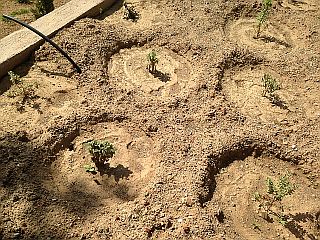
These tiny plants will be watered in their first year and then expected
to survive on what nature provides
Photo by Robin McGrew
Our visit and the lovely tea that followed was a real treat. I would like to thank the owners and the designers for creating and sharing with us such a beautiful and well-maintained garden that demonstrates so very well the principles of climate-appropriate and waterwise planting.
Robin McGrew
We encourage all participants in our events to follow Robin’s example and send us their comments.
January 2014
A day trip to Aegina
We had visited Aegina’s ancient olive grove before not too many years ago, but before the economic crisis and the high cost of fuel oil placed forests, even irreplaceable ones with age-old trees, at risk of being felled for firewood. Concern for the fate of Aegina’s magnificent olives was the initial motive for our January 25th trip, but when a friend, Eleni Zachariou, who lives on the island, pronounced them intact, we decided at her suggestion to broaden our excursion to include some other points of interest.
Eleni, who also happens to be a professional archaeological guide, was waiting for us near the beach of Marathonas, where a very washed-out, steep path leads up to the olive grove. We paused for breath before the final ascent, where she gave us a brief history of the island and told us that the grove, about 12,000 stremmata/12 square kilometres in area, is the property of a local monastery and that no one knows the age of the trees.


Photos by Frosso Vassiliades
Moving upward to the crest of the hill, those of us who hadn’t been there before were taken by surprise. This was not your usual olive grove with neatly spaced rows of trees. Instead, a wide valley stretched before us, dotted with gnarled ancient trees at irregular intervals and studded with red volcanic boulders. Among the trees, the land was rocky and cloaked in classic phrygana vegetation. In places there were large piles of boulders with trees growing on top of the rocks. Probably the soil had washed away over the centuries leaving their roots exposed, whereas once roots and rocks were both underground. These trees are so old their trunks are completely hollow, making it impossible to tell their age by counting the rings. Photographers were in heaven here, entranced by the intricate shapes in the old wood.

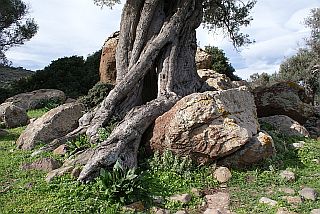
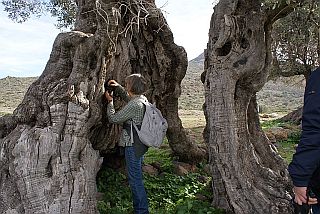
Photos by Frosso Vassiliades
After a few hours’ circular walk that took in a large number of spectacular Methuselahs, we quelled our hunger pangs on the terrace of a waterfront taverna, Stratigos, that served a variety of delicious dishes, and, to the delight of some old timers, excellent old-fashioned retsina. The forecast bad weather arrived with impeccable timing just as we were leaving for our next destination, Eleni Kypraiou’s pistachio farm. Ms Kypraiou, a well-known journalist in a former life, greeted us at the entrance of her grove and led us into her workplace, where she not only dries her pistachios, but also makes oil and ‘butter’ from them. Then we squeezed into an anteroom in her home, where she treated us to scrumptious cake. While we nibbled, out of the rain, Eleni Zachariou had arranged for another interesting woman, Vasso Kanellopoulou, to speak to us.
Vasso is the local representative of Peliti (www.peliti.gr), a Greek non-profit organisation involved in the protection, collection and dissemination of traditional or “farmers’” seeds. These are under grave threat, to a large extent because EU legislation promotes standardised and uniform commercial varieties based on criteria that are not suitable for non-commercial, traditional seeds. She painted a grim picture of unenforced guidelines being reworded as strict regulations due to pressures from ten multinational companies, despite the opposition of the populations of 28 member states. Peliti, which has 200 volunteers who keep the purity of locally adapted landraces and operates on a shoestring, attempts to educate children and communities in ecofriendly principles and seed seed saving and promotes the use of public domain seeds which are free of intellectual property rights or patents. Peliti also maintains a seedbank with 2000 accessions as well as 12 ‘lively local chapters’ around the country. Vasso raised concerns about the limited funding of the precious National Seed Bank in Thessaloniki, which keeps 15,000 accessions of crop seeds and wild relatives of these seeds; the bank needs funds for the maintenance of the refrigerating equipment and for reproduction of its seeds at specific time intervals depending on the species, as seed ability for reproduction diminishes with time. Our speaker questioned the logic of reducing biodiversity just to satisfy the greed of certain giant corporations. We could have listened to her for hours, but time was running short and we had one more place to visit.

A glimpse of the historic Voulgaris mansion, built in 1860,
surrounded by lush greenery
Photo by Diana Farr Louis
Virtually around the corner from Eleni Kypraiou’s farm, the historic estate of the Voulgaris family awaited us. Here our hosts not only had a fabulous garden to show us, they also shared their art. Theodora (Theo) Chorafa, a descendant of the original owners who built the first house 150 or so years ago, is a skilled potter, and her husband, Aspe Coulon, is a brilliant photographer who had made a series of dramatic portraits of the very olive trees we’d seen earlier. But before entering their studios we took a tour of the garden with its old, healthy palm trees, enormous ficus, galloping bougainvillea and a cactus/succulent zone that surrounded the buildings, a windmill dating from 1791, a ‘cottage’ where Capodistrias, the first Greek president, slept, and the imposing main house, built in 1860, for Demetrios Voulgaris, who served as prime minister no less than eight times.
Arriving back at the port, we had barely enough time to stock up on more pistachios before boarding the ferry. But all agreed it had been a wonderful day, especially thanks to Eleni Zachariou and the inspiring Aegina residents she introduced us to.
Frosso Vassiliades and Diana Farr Louis |


